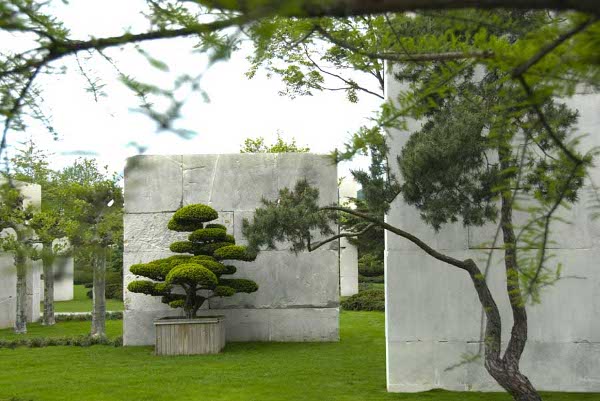There is a wide-ranging and fascinating exhibition currently on show at Savannah's Telfair Museums, at the Jepson Center, entitled Modern Masters. American Abstraction at Midcentury". With works from the Smithsonian American Art Museum, the explosive diversity of art made during the mid-20th century in America is celebrated with forty-three key paintings and sculptures. The exhibition is travelling the country for four years, and it will remain on display at the Jepson until February 6th, 2011.
It is a show worth visiting several times, because of its diversity and density. Not only are there canvases by stellar artists to contemplate and appreciate, but there are some fascinating sculptures that I found most arresting.
One of them, "Banquet", shown courtesy of the Smithsonian American Art Museum, stopped me in my tracks with its multi-layered knobbly forms and metal alloys that evoke stalagmites or primitive corals. It is by an artist with whom I was unfamiliar, Ibram Lassaw (1913-2003).
Ibram Lassaw, Banquet, 1961, bronze, Smithsonian American Art Museum, Ibram Lassaw, Banquet, 1961, bronze, Smithsonian American Art Museum,
(As an aside, I find that being a permanent newcomer to every place I have lived in Europe and North America since I had to leave my home in East Africa, I am constantly having to "catch up" on art, law, history, society in general – It is a humbling but exhilarating situation!)
But back to Ibram Lassaw. He too was an immigrant, from Egypt, working in New York as an artist from the 1920s; he became an active participant in the avant-garde art world and was a founding member of the American Abstract Artists. He learned to weld while serving in the US Army during World War II, and continued experimenting with ideas and materials for the next two decades. He fused his ideas on art-making with concepts derived from extensive and catholic reading to reach a philosophy about the holistic nature of the universe and all that is contained therein. He suddenly had an artistic breakthrough in the 1950s, and began to create complex structures that evoked nature in many forms, cosmic and microcosmic.
He said that everything is nature, "every atom that makes me up is nature". He wrote, "I am constantly absorbed by things that are going on around me, the motion of people in the streets, the movement of clouds, the patterns of branches. There is no duality, everything is nature."
It was obvious from the work, "Banquet" that he was fusing ideas about many aspects of life and nature in this work, to achieve a delicate complex work that rewards with careful inspection and contemplation. What I found so interesting, however, was one of those delicious coincidences that occurs: soon afterwards, I saw a re-broadcast on PBS of Hunting the Hidden Dimension. The Most Famous Fractal about the late Benoit Mandelbrot's wonderful mathematical way of describing the "roughness" he saw all around him in nature. Before Mandelbrot, artists had indeed seen the "self-similarity" and "roughness" in nature, but mathematicians had considered these jagged, self-repeating shapes unmeasurable. Mandelbrot introduced fractals, the concept of another dimension, a fractal dimension, that lay between two and three dimensions. This dimension allows for mathematical measurements and thus, amongst other things, a deeper understanding of self-similarity - the endless repetition of stalks of broccoli, trunks to branches to twigs on a tree and its leaves.
As an example, the image below is that of a high voltage dielectric breakdown within a block of plexiglass - it creates a beautiful fractal pattern called a Lichtenberg figure. The branching discharges ultimately become hair-like but are thought to extend down to the molecular level. (Bert Hickman. http://www.teslamania.com/)
12" block - Captured Lightning scupture (Image courtesy of Theodore Gray)
Lassaw's "Banquet", created in 1961, was in many ways an early evocation of the same wonderful complexity that nature offers, everywhere, all the time.
These happy coincidences are what I love about seeing an art exhibition. There is always some work of art that makes one more aware, more able to make connections and add new, rich dimensions to life. What fun!














